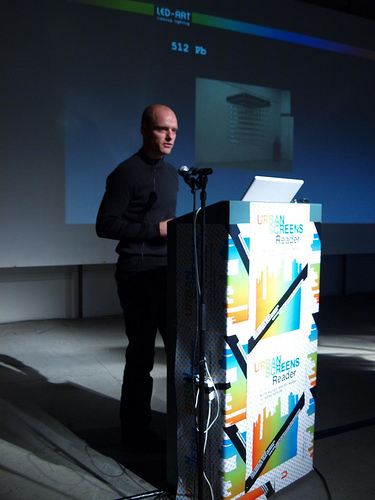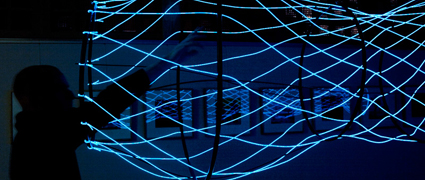 Paul Klotz is an applied art engineer and light designer who specializes in interactive light installations for public spaces. By means of light and sound installations which create a feedback loops between the passerby and the installation upon physical interaction with the artwork, he attempts to set up in public spaces artistic zones which captivate, entertain and enrich human experience. The Tunnel Vision installation for example is a light and sound installation which responds to the individual’s hand movements within it by sound and light alterations.
Paul Klotz is an applied art engineer and light designer who specializes in interactive light installations for public spaces. By means of light and sound installations which create a feedback loops between the passerby and the installation upon physical interaction with the artwork, he attempts to set up in public spaces artistic zones which captivate, entertain and enrich human experience. The Tunnel Vision installation for example is a light and sound installation which responds to the individual’s hand movements within it by sound and light alterations.
Besides a couple of more politically determined projects such as the as the EL-37 (Eco-Line 37), the primary function of Paul Klotz’s creative lighting installations is aesthetic and stems from his fascination with light as artistic medium. EL-37 (Eco-Line 37) was installated in the urban space of Almelo. The installation consists of a six meter modular lightline, something like a thermometer which represents in colours the temperature at the place of the installation. The displayed temperature fluctuates according to the different types of transportation in transit by the place of installation as a modality of creating awareness of environmental issues, climate change and the role of pollution in the process. In absence of traffic the installation acts as a blow-up thermometer.

The sense of individual engagement is determined in Klotz’s installations by the responsiveness of the installation to the movements of the passerby, enabled by the data gathered by sensors at the location of the installation. This much praised feature of interactivity emphasized by many of the media installations and projects presented today at the conference deserves more interrogation. Individual engagement and agency are not to be made the primary goal of such projects and admired as accomplishments in themselves but further interrogated in terms of their meaningfulness. Interactivity in itself can enable both responsible and irresponsible engagement with the artwork/ installation. In order to make the interactive features of an artwork meaningful the attention of the artist should go towards enabling responsible interaction and empathy through conceptual choices. Kristine Stiles and Edward Shanken, art theorists and historians, provide a list of questions useful in reflecting upon whether the interactive features of multimedia artworks truly enable responsible and meaningful agency in relation to social change, agency which would activate complex emotional and decision-making responses and which would contribute to the meaningfulness of the overall artwork, defined as “the ability to change (or affirm) the way viewers see, understand, and act upon the world” (Stiles and Shanken, forthcoming: 86).
In what ways does their [contemporary artists’] use of interactive media: a) challenge or change the creative process and the ways in which artistic meaning is constructed and received? b) enable alternative or expanded roles for the viewer as a producer of meaning? c) enhance individual and collective agency as a vehicle for social change? How are the intentions of the artist and the participant related to the events that result from encounters with interactive art? Do participants have the freedom to influence real-world events or assume interconnected responsibility? (Stiles and Shanken, forthcoming: 91)
This set of questions brings me to another question which I would have liked to be addressed in the presentation of each art project namely, beyond their obvious spectacularity and the ‘coolness’ factor, what is the ‘added-value’ in terms social capital/change/ efficacy, of these sometimes very expensive thereby largely inaccessible forms of expression in urban space interventions, in comparison with older forms of artistic/ tactical/ subversive/ socially-oriented interventions in urban space?
Notes:
Kristine Stiles and Edward A. Shanken, Missing in Action: Agency and Meaning in Interactive Art, forthcoming in Margot Lovejoy, Christiane Paul, Victoria Vesna, eds., Context Providers: Context and Meaning in Digital Art (University of Minnesota Press).


